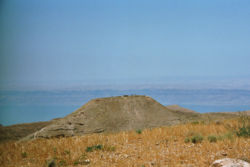- Machaerus
-
Machaerus (from μάχαιρα, a sword, Arabic: ِقلة المشناقى Qalatu l-Mishnāqá, Hebrew מכוור) is a fortified hilltop palace located in Jordan fifteen miles (24 km) southeast of the mouth of the Jordan river on the eastern side of the Dead Sea. According to Flavius Josephus, it is the location of the imprisonment and execution of John the Baptist.[1]
Contents
History
The fortress Machaerus was originally built by the Hasmonean king, Alexander Jannaeus (104 BC-78 BC) in about the year 90 BC.[2] It was destroyed by Pompey's general Gabinius in 57 BC,[3] but later rebuilt by Herod the Great in 30 BC to be used as a military base to safeguard his territories east of the Jordan.
Upon the death of Herod the Great, the fortress was passed to his son, Herod Antipas, who ruled from 4 BC until 39 AD. It was during this time, at the beginning of the first century AD, that John the Baptist was imprisoned and beheaded at Machaerus.[4]
After the death of Herod Antipas (39 AD), Machaerus passed to Herod Agrippa I until his death (44 AD), after which it came under Roman control. Jewish rebels took control after 66 AD during the First Jewish Revolt.[5] Shortly after defeating the Jewish garrison of Herodium, the Roman legate Lucilius Bassus advanced on Machaerus with his troops and began siege in 72 AD. An embankment and ramp were created in order to facilitate Roman siege engines but the Jewish rebels capitulated before the Roman attack had begun. The rebels were allowed to leave and the fortress was torn down, leaving only the foundations intact.
Design
Josephus gives a full description of Machaerus in The Wars of the Jews 7.6.1 ff. The hilltop, which stands about 1,100 meters above Dead Sea level, is surrounded on all sides by deep ravines which offer great natural strength. The valley on the west extends 60 stadia to the Dead Sea (Josephus refers to it as Lake Asphaltitis). The valley on the east falls away to a depth of a hundred cubits (150 ft).
Herod the Great regarded the place as deserving the strongest fortification, particularly because of its proximity to Arabia. On top of the mountain, surrounding the crest, he built a fortress wall, 100 meters long and 60 meters wide with three corner towers, each sixty cubits (90 ft) high. The palace was built in the center of the fortified area. Numerous cisterns were provided to collect rain water.
Excavation
The village on the plateau to the east of the mountain is known Muqāwir (Arabic: مقاور). The site was visited in 1807 by the Frisian explorer Ulrich Jasper Seetzen, and the name of the village reminded him of the name of Machaerus in Greek. The archaeological excavation of Machaerus was begun in 1968 by Jerry Vardaman, then of the Southern Baptist Theological Seminary, and later director of the Cobb Institute of Archeology at Mississippi State University. In 1973, the German scholar, August Strobel, identified and studied the wall by which the Romans encircled the defenders within the fortress. In 1978-1981, excavations were carried out by Virgilio Corbo, Stanislao Loffreda and Michele Piccirillo, from the Franciscan Biblical Institute in Jerusalem.
Within the fortified area are the ruins of the Herodian palace, including rooms, a large courtyard, and an elaborate bath, with fragments of the floor mosaic still remaining. Farther down the eastern slope of the hill are other walls and towers, perhaps representing the "lower town," of which Josephus also speaks.[6] Traceable also, coming from the east, is the aqueduct that brought water to the cisterns of the fortress. Pottery found in the area extends from late Hellenistic to Roman periods and confirms the two main periods of occupation, namely, Hasmonean (90 BC-57 BC) and Herodian (30 BC-AD 72), with a brief reoccupation soon after AD 72 and then nothing further—so complete and systematic was the destruction visited upon the site by the Romans.
External links
- Machaerus, article in historical sourcebook by Mahlon H. Smith
- Machaerus, Jordan
- The Franciscan Archaeological Institute's Page on "The Fortress at Machaerous"
Excavation Reports
- Corbo, V. (1978) La fortezza di Macheronte: Rapporto preliminare della prima campagna di scavo: 8 settembre - 28 ottobre 1978. Liber Annuus 28: 217-238.
Footnotes
- ^ Eerdmans Dictionary of the Bible 2000 ISBN 9053565035 page 583
- ^ Josephus, The Wars of the Jews 7.6.2
- ^ Josephus, The Wars of the Jews 1.8.5
- ^ Josephus Antiquities of the Jews 18.5.2
- ^ Josephus, The Wars of the Jews 2.18.6
- ^ Josephus, The Wars of the Jews 7.6.4
See also
Coordinates: 31°34′01″N 35°38′01″E / 31.56694°N 35.63361°E
Categories:- Jews and Judaism in the Roman Empire
- Archaeological sites in Jordan
- Hill forts
- History of Israel
- Jewish–Roman wars
- Jews and Judaism in Jordan
- Mountain monuments and memorials
Wikimedia Foundation. 2010.

